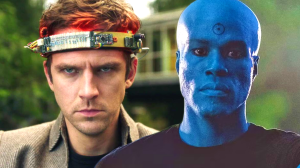To say that the status of the Hellraiser franchise from Clive Barker has waned in recent years would be a bit of an understatement, especially given how iconic the franchise’s “Pinhead” has grown since Doug Bradley first brought the figure to life in 1987. Despite the pop culture impact of Pinhead after his live-action debut, 1996’s Hellraiser: Bloodline was the final entry to be released in theaters, with the franchise instead being relegated to home video. The spirit of the series was kept alive in novels and comic books, but it’s a world that is brimming with potential that has failed to be realized. Luckily, director David Bruckner’s Hellraiser manages to honor all the grotesque glory of the franchise in a way that feels fresh, opening up the Lament Configuration for even more stories to be told in this disturbing dimension.
Videos by ComicBook.com
Desperate for cash and for a new lot on life, struggling addict Riley (Odessa A’zion) comes into possession of a mysterious puzzle box, with the discovery of the relic’s many shapes seeing those closest to her pay a deadly price, as hideous beings from another realm cash in on the bargain Riley unwillingly agreed to.
The complex and twisted nature of the world of Hellraiser is both a blessing and a curse. Unlike other horror franchises, there isn’t as strong of a connection among the narrative timelines of the protagonists, instead using the demonic Cenobites as its consistent throughline. This has allowed various installments to jump to disconnected points in time in this world and explore entirely different characters, so long as one of them crosses paths with the puzzle box and eventually the Cenobites. In this regard, this new Hellraiser might be billed as a “reboot” to some (remake to others), but the disconnect between each installment allows this film the freedom to merely be a new chapter as opposed to being held to a specific standard or source material.
Director Bruckner and writers Ben Collins and Luke Piotrowski used Barker’s original story “The Hellbound Heart” as their inspiration, yet those expecting a beat-for-beat rehash of either the original story or first film will be in for a surprise. This trio of filmmakers delivered one of 2021’s best horror movies with The Night House, which shares some narrative DNA with Hellraiser. The nature of this story sees the inclusion of a narrative, figurative ticking clock, organically amplifying the stakes towards some horrifying crescendo. Even though there are some drags in the story’s momentum, the structure of the concept comes with a subconscious countdown to help keep the audience invested.
In addition to the lack of overall continuity setting Hellraiser apart from other franchises, another key difference is its balance of deaths and violence. Whereas other series focus on brutal killers committing heinous murders, there’s a beauty and grace in the carnage of the Cenobites, as the torture scenes and hideous creatures you both can’t take your eyes off of yet can’t turn away fast enough from. Bruckner manages to honor that spirit, incorporating a variety of unsettling elements that are stomach-churning yet not just for the sake of gore. Whereas the horror genre began exploring the “torture porn” approach to filmmaking in the 2000s, testing the limits of what gruesome things they could subject audiences to, Bruckner’s visual violence seems to walk right up to the edge of nauseating and just slightly reins it, making sure viewers can survive the intensity, but just barely.
Along with the inherent nature of this new Hellraiser earning the moniker of being a reboot (though a “legacyquel,” as coined by ScreenCrush‘s Matt Singer, feels far more appropriate here), another point of discussion is that Pinhead, played in the 10 previous films by a male actor, was played in this Hellraiser by female performer Jamie Clayton. Those familiar with the source material know that this figure — known as the “Hell Priest” or “Lead Cenobite” and only earned the Pinhead moniker from fans — is defined as being genderless though with some feminine-leaning features, so having Clayton take on the role feels more authentic to Barker’s initial intent than even Bradley’s casting. Between having a female performer embodying the villain and the tweaks to the character design, combined with Clayton’s haunting and ethereal performance as opposed to Bradley’s more menacing take on the demon, this Pinhead feels entirely like its own thing yet one that honors everything that makes the villain so unsettling. While the Pinhead actors in Hellraiser: Revelations and Hellraiser: Judgment were lambasted by fans for not being Bradley, Clayton’s version is both different enough yet honors enough about the iconic villain that it can stand side by side with Bradley’s accomplished character without ever taking away from it, which is really all one could hope for as a fan of the franchise.
As compared to franchises like Halloween or A Nightmare on Elm Street, the inherent demonic and grotesque qualities of Hellraiser prevent it from being as marketable or as appealing as its peers. These traits are just as apparent in this new Hellraiser as they are in the series’ standout entries, as its blend of sado-masochism with romance and eroticism is far too overwhelming for the general public, though, this is arguably as it should be. Hellraiser will never find the mass appeal of other franchises, but when it resonates with a viewer, it passionately resonates with them, which is what has kept faith in the franchise alive for all these decades. This new take on Hellraiser is just as gruesomely gorgeous as the best entries in the franchise and its narrative is engaging enough to keep us interested, despite knowing how many of our protagonists will feel the pain of the Cenobites, both to the delight and dismay of viewers. We only hope that this Hellraiser and Jamie Clayton’s Hell Priest bring the pain and pleasure of the series back to its rightful throne of glory.
Rating: 4 out of 5
Hellraiser lands on Hulu on October 7th.








